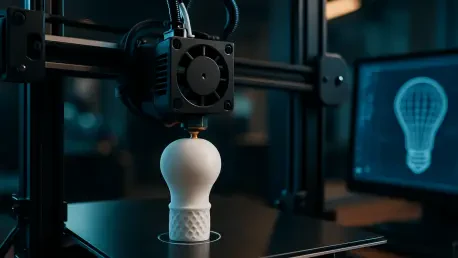Picture a future where 3D printing delivers flawless metal components with unerring precision, eliminating the guesswork and defects that often plague additive manufacturing. Oak Ridge National Laboratory (ORNL), through its Manufacturing Demonstration Facility under the Department of Energy, has brought this vision closer to reality with the release of a transformative dataset. Designed specifically for the laser powder bed fusion (L-PBF) process, this dataset integrates a vast array of data points to enhance quality control in 3D printing. It combines in-situ imaging, sensor readings, and fatigue performance metrics to address the critical link between manufacturing anomalies and the final product’s integrity. This advancement marks a significant milestone for industries such as aerospace and automotive, where precision and reliability are paramount. By harnessing this resource with cutting-edge software, ORNL is paving the way for smarter, more dependable production methods that could redefine how complex parts are created and trusted in high-stakes applications.
Unveiling the Dataset’s Core Features
Exploring a Wealth of Information
The dataset released by ORNL stands out for its comprehensive scope, capturing an extensive range of data from the L-PBF process. It includes machine process parameters, intricate sensor readings, and high-resolution images taken under diverse lighting and angles. By merging visible light, near-infrared imaging, and X-ray computed tomography scans, this collection offers a multidimensional view of each printed layer. Such depth allows for the detection of internal defects that might otherwise go unnoticed with conventional inspection methods. This level of detail is invaluable for manufacturers aiming to ensure that every component meets stringent quality standards. The ability to scrutinize the minutiae of the printing process through varied data sources empowers stakeholders to pinpoint issues at their root, fostering a deeper understanding of how different variables interplay during production. As a result, this dataset serves as a foundational tool for refining techniques and minimizing errors in additive manufacturing workflows across multiple sectors.
Linking Data to Performance Outcomes
Beyond its diverse data points, the dataset’s true strength lies in its capacity to correlate manufacturing irregularities with mechanical performance. Fatigue data from tested specimens provides direct insights into how specific flaws, such as internal voids or surface inconsistencies, impact a part’s durability over time. This connection is crucial for industries where failure is not an option, as it enables predictive analysis to prevent potential breakdowns before they occur. The integration of X-ray scans further enhances this capability by revealing hidden structural weaknesses that could compromise a component’s integrity under stress. For engineers and researchers, this means a clearer path to designing parts that withstand real-world conditions without sacrificing efficiency. By offering such a detailed mapping of cause and effect, ORNL’s dataset not only highlights problem areas but also guides the development of solutions tailored to specific challenges, ensuring that 3D-printed parts are both robust and reliable in demanding applications.
The Power of Peregrine Software
Harnessing Real-Time Insights
Central to the impact of ORNL’s dataset is the Peregrine software, a sophisticated tool that leverages artificial intelligence to monitor 3D printing processes as they unfold. By analyzing each layer of a part during the L-PBF process, Peregrine creates a three-dimensional map of potential issues, enabling operators to address anomalies in real time. As noted by Luke Scime, a researcher at ORNL, the software meticulously examines pixel data to identify edges, textures, and other indicators of defects, providing immediate alerts for corrective action. This proactive approach significantly reduces the likelihood of producing substandard components, saving both time and resources. The synergy between the dataset’s rich information and Peregrine’s analytical prowess transforms quality assurance from a reactive to a preventive endeavor. Manufacturers can now intervene at the earliest sign of trouble, ensuring that each part aligns with exacting standards before it progresses further in the production cycle, thus enhancing overall output quality.
Advanced Algorithms Driving Precision
Delving deeper into Peregrine’s capabilities reveals the role of advanced AI, specifically the Dynamic Multilabel Segmentation Convolutional Neural Network (DMSCNN). This algorithm integrates data from multiple sensors to detect specific anomalies like spatter—molten material ejected during printing that can disrupt a part’s surface and structural integrity. The dataset complements this technology by providing detailed records of spatter occurrences and their effects on fatigue-tested specimens, establishing a clear link to long-term performance. Such precision allows for a granular understanding of how even minor disruptions can cascade into significant issues if left unchecked. By mapping these correlations, DMSCNN equips manufacturers with the knowledge to refine their processes, minimizing defects that could undermine a component’s functionality. This targeted application of AI, supported by ORNL’s comprehensive data, marks a leap forward in achieving consistency and reliability, setting a new benchmark for what’s possible in additive manufacturing environments.
Industry-Wide Implications
Sparking Global Innovation
One of the most transformative aspects of ORNL’s dataset is its open-source availability, a decision that amplifies its reach and potential impact across the additive manufacturing landscape. By making this resource freely accessible, ORNL invites researchers, engineers, and companies worldwide to tap into a treasure trove of data for developing enhanced AI models and quality control systems. This democratization of cutting-edge information fosters a collaborative environment where innovations can flourish without the barriers of proprietary restrictions. The potential for creating adaptive, data-driven solutions becomes limitless as diverse stakeholders contribute their expertise to refine 3D printing technologies. From academic institutions exploring theoretical advancements to industrial players optimizing production lines, the shared access to this dataset catalyzes a wave of progress that could redefine standards of efficiency and precision, ultimately benefiting the entire sector with more robust and reliable manufacturing outcomes.
Tackling Persistent Challenges
The dataset also addresses specific pain points in 3D printing, such as the detrimental effects of spatter and other process irregularities that can weaken final products. By offering detailed insights into how these anomalies correlate with mechanical performance, it provides a roadmap for mitigating risks that have long plagued additive manufacturing. Manufacturers gain the ability to adjust parameters and techniques based on concrete evidence, reducing material waste and enhancing part longevity. This focused approach to problem-solving is particularly valuable in high-stakes industries where even minor defects can lead to catastrophic failures. The data-driven strategies enabled by this resource allow for a more informed calibration of the L-PBF process, ensuring that each layer contributes to a structurally sound whole. As a result, the dataset not only identifies critical issues but also equips the industry with actionable knowledge to overcome them, paving the way for more consistent and dependable production practices.
The Future of Smart Manufacturing
Aligning with Digital Trends
ORNL’s dataset emerges as a cornerstone in the broader shift toward digitalization and smart manufacturing, reflecting a growing reliance on data to drive industrial innovation. By integrating comprehensive information with AI tools like Peregrine, it exemplifies how technology can elevate 3D printing into a consistently dependable process. This alignment with industry trends underscores the importance of real-time analysis and predictive capabilities in reducing errors and optimizing outcomes. As manufacturing continues to evolve, such datasets play a pivotal role in ensuring that additive processes keep pace with the demand for precision and efficiency. The groundwork laid by this initiative points to a future where digital tools and data integration become standard, transforming how industries approach the creation and validation of complex components with unprecedented accuracy.
Building a Foundation for Progress
Looking back, the release of this dataset by ORNL marks a defining moment that sets the stage for ongoing advancements in additive manufacturing. It provides a robust framework for addressing quality control challenges through AI and detailed data analysis, ensuring that defects are caught and corrected during production. The open-source nature of the resource encourages widespread collaboration, inviting global contributions to refine and expand upon the initial findings. Moving forward, stakeholders are urged to leverage this foundation to develop even more sophisticated monitoring systems and manufacturing strategies. By continuing to build on the insights gained, the industry can anticipate further innovations that will solidify 3D printing as a cornerstone of modern production, offering reliable solutions for the most demanding applications.









